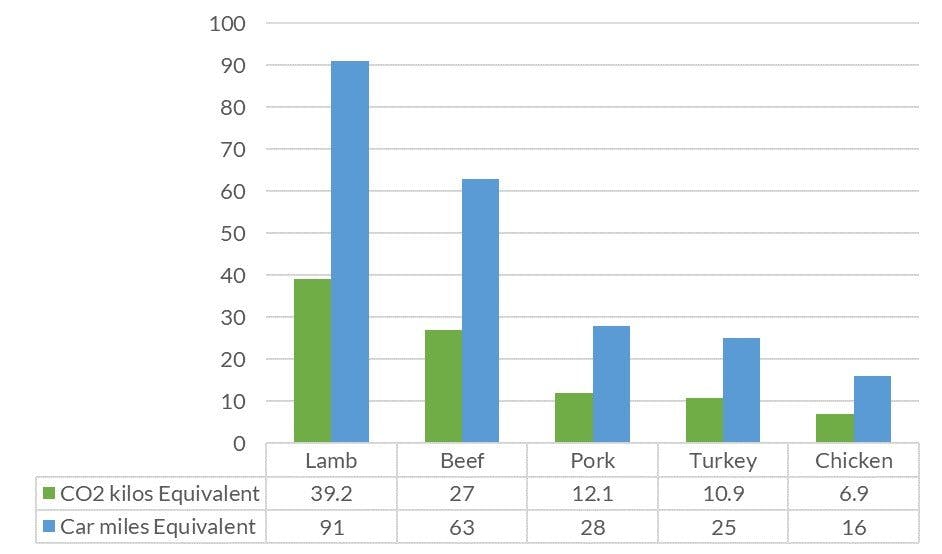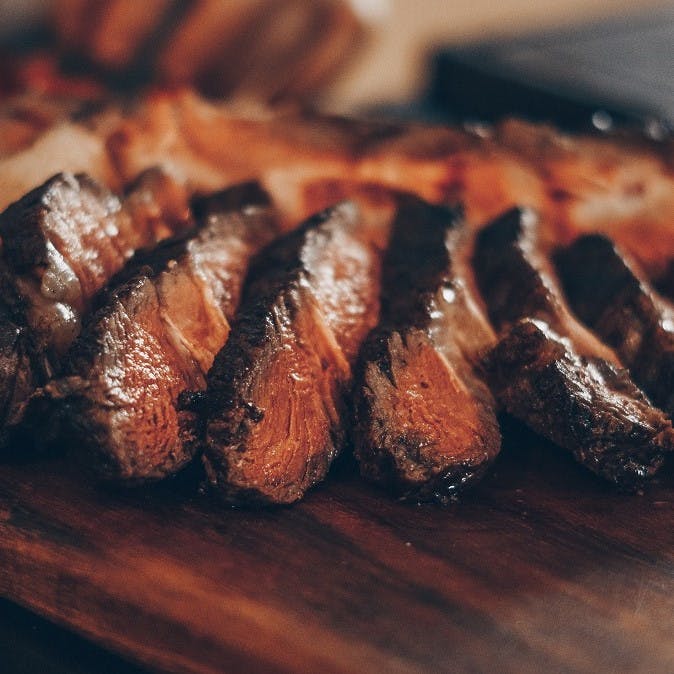
Matt Davies
If veganism and vegetarianism is a bridge too far for you, and they’re not for everyone, another way you can reduce your carbon footprint by way of diet, is to replace red meat with white meat.
Eating meat and Climate Change
Meat contributes to climate change through its related Greenhouse Gas (GHG) emissions, land and water use and the impact of fertilizers applied during farming. Recent research into the global food system found that animal products produce the majority of food related GHG emissions (72-78%). These are caused by low feed-conversion efficiencies, enteric fermentation (a digestive process where ruminant animals release methane, a potent GHG) and manure-related emissions. In the same research paper, published in the journal Nature, a stark prediction warns that our current food system is tipping the scales against our environment unsustainably and if changes don't occur by 2050 we will have exceeded safe planetary boundaries for humans.
Thankfully, the team of leading scientists on this study as well as experts on the UN’s Intergovernmental Panel on Climate Change (IPCC) see chances to adapt and mitigate against climate change. This is provided there is a shift towards plant-based diets and sustainable animal products, a reduction in food waste, and more sustainable farming practices.
Understandably for meat-lovers, completely changing eating habits is not necessarily easy, this can be particularly difficult if meat forms part of a strong cultural identity ingrained in societies. However, cutting down on meat will reduce the pressure on the planet’s finite resources immensely, in addition to the associated health benefits of increasing peoples’ intake of plant-based foods.

Currently, 260 million acres (and counting) of U.S. forests have been clear-cut to create land used to produce livestock feed, and 80 percent of the deforestation in the Amazon rainforest is attributed to beef production.
One Green Planet
CO2 emissions per kilo of food
This table on the left shows the CO2 emissions produced by one kilo of each food. It includes all the emissions produced on the farm, in the factory, on the road, in the shop and in your home.
According to Foodtank, the total amount of water needed to produce one pound of beef is 6809 liters of water; one pound of pork takes 2180 liters of water. In comparison, the water footprint of poultry is 1771 liters. While 2 – 5 acres of land is required per cow compared to 1 acre for 50 – 100 free range chickens.
The stats speak for themselves, choosing white meat over red meat goes a long way towards reducing your impact on our ecosystems.


Take action now
Do you want to have a direct impact on climate change? Sir David Attenborough said the best thing we can do is to rewild the planet. So we run reforestation and rewilding programs across the globe to restore wild ecosystems and capture carbon.
Get involvedHow to make the switch from red meat to white meat
Contrary to popular belief a new habit takes a bit longer than 21 days to form completely…
Researchers from University College London published an article in which they estimate the average time to be 66 days with some variation between people and habits. So, you needn’t go cold turkey on your red meat, no pun intended, but rather reduce red meat consumption over 66 days to build the habit. Over a 66 day period, someone eating 100g of white meat each day vs a person eating 100g of red meat would reduce their carbon footprint by 113 kilos of CO2 or 267 car miles.

Become inspired and stay motivated
Take advantage of the challenge to reduce red meat consumption by experimenting with new dishes, recipes and ideas with white meats.
There is a wealth of cooking ideas on the internet and/or easy to follow recipe books in all good book shops. Invite a friend, family member or work colleague to join you on the challenge. Having someone in the same predicament as yourself makes the switch much easier.
Here are 5 easy and delicious white meat dishes one should have in their repertoire.

Health benefits of white meat
By opting for white meat over red meat, you will not only be reducing your carbon footprint, but helping to improve your health.
According to the NHS and Heart Org, red meats such as beef, lamb and pork are a good source of protein, vitamins and minerals, and can form part of a balanced diet. But eating a lot of red meat, which in general has more saturated and trans fats than white meats, can raise your blood cholesterol, increase the chances of heart disease and increase the probability of bowel cancer. It is therefore recommended that people who eat more than 90g of red meat per day cut down to 70g to reduce these risks. By opting for white meat over red, you will not only be reducing your carbon footprint, but helping to improve your health.

Cutting back on the red meat
Meat consumption is a delicate issue for many, but the researchers are not saying that you should stop eating steak and burgers entirely; rather reducing your intake will significantly cut your carbon footprint.
Fish or even insects can be great substitutes when trying to cut back on red meat. Head over to our Flexitarian Diet, Pescatarian Diet and Edible Insects guides to learn more about the benefits to your health and carbon footprint.


Choose white meat over red meat to minimise your environmental impact and boost health
Sources & further reading

- “The price of protein: Review of land use and carbon footprints from life cycle assessments of animal food products and their substitutes” - sciencedirect.com
- “Greenhouse gas emissions from the EU livestock sector: A life cycle assessment carried out with the CAPRI model” - sciencedirect.com





 Get creative in the kitchen
Get creative in the kitchen